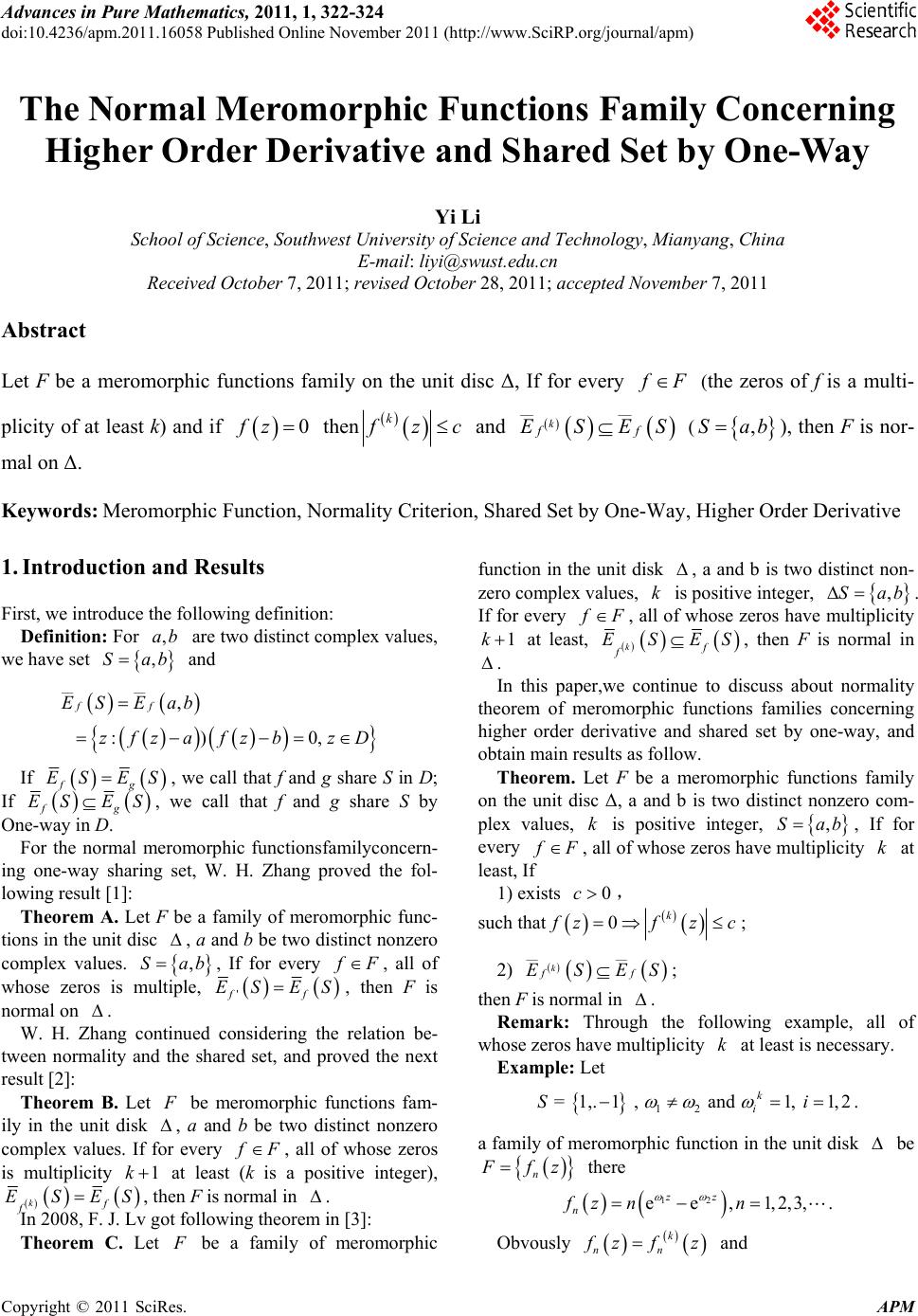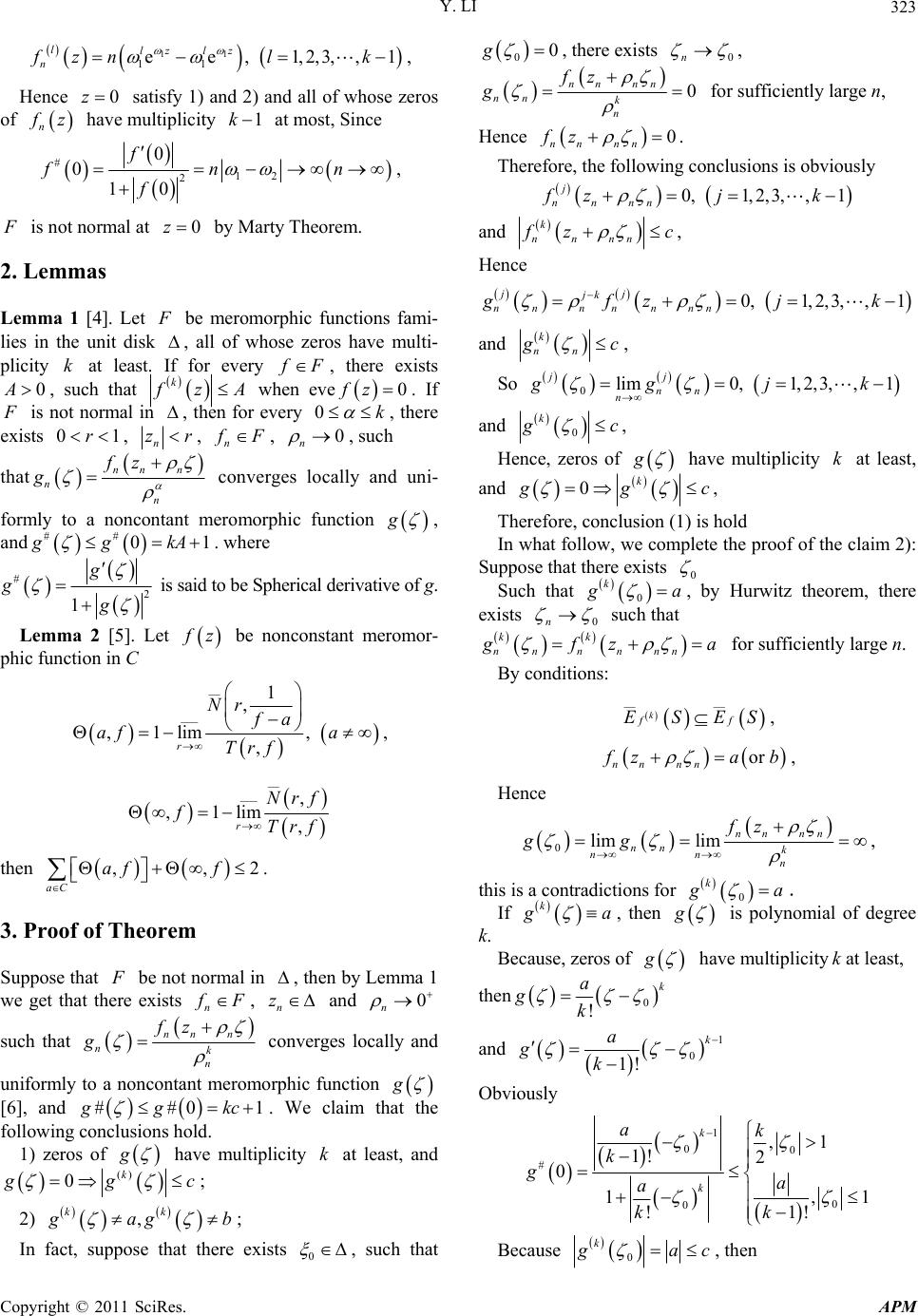 Advances in Pure Mathematics, 2011, 1, 322-324 doi:10.4236/apm.2011.16058 Published Online November 2011 (http://www.SciRP.org/journal/apm) Copyright © 2011 SciRes. APM The Normal Meromorphic Functions Family Concerning Higher Order Derivative and Shared Set by One-Way Yi Li School of Science, Southw est Universi t y of Scie nce a nd Te chn olo gy, Mianyang, China E-mail: liyi@swust.edu.cn Received October 7, 2011; revised October 28, 2011; accepted November 7, 2011 Abstract Let F be a meromorphic functions family on the unit disc Δ, If for every F (the zeros of f is a multi- plicity of at least k) and if 0fz then k zc and __ __ k ff SES ( ,Sab), then F is nor- mal on Δ. Keywords: Meromorphic Function, Normality Criterion, Shared Set by One-Way, Higher Order Derivative 1. Introduction and Results First, we introduce the following definition: Definition: For are two distinct complex values, we have set and ,ab ,bSa __ __ , :)0, ff ES Eab zfza fzbzD If fg ES ES, we call that f and g share S in D; If fg ES ES, we call that f and g share S by One-way in D. For the normal meromorphic functionsfamilyconcern- ing one-way sharing set, W. H. Zhang proved the fol- lowing result [1]: Theorem A. Let F be a family of meromorphic func- tions in the unit disc , a and b be two distinct nonzero complex values. , If for every ,Sa b F, all of whose zeros is multiple, f S 'f ES E, then F is normal on . W. H. Zhang continued considering the relation be- tween normality and the shared set, and proved the next result [2]: Theorem B. Let be meromorphic functions fam- ily in the unit disk , a and b be two distinct nonzero complex values. If for every , all of whose zeros is multiplicity at least (k is a positive integer), 1 fF k S kf f In 2008, F. J. Lv got following theorem in [3]: ESE, then F is normal in . Theorem C. Let be a family of meromorphic function in the unit disk , a and b is two distinct non- zero complex values, is positive integer, k ,Sab . If for every fF , all of whose zeros have multiplicity 1k at least, kf f ESES, then F is normal in . In this paper,we continue to discuss about normality theorem of meromorphic functions families concerning higher order derivative and shared set by one-way, and obtain main results as follow. Theorem. Let F be a meromorphic functions family on the unit disc Δ, a and b is two distinct nonzero com- plex values, is positive integer, , If for every k F ,bSa f , all of whose zeros have multiplicity at least, If k 1) exists , 0c such that 0k fzfz c ; 2) ; __ __ k ff ESE S then F is normal in . Remark: Through the following example, all of whose zeros have multiplicity at least is necessary. k Example: Let = 1,. 1 , and 1, k i Si 12 1, 2. a family of meromorphic function in the unit disk be n fz there 12 ,1,2,3 zz n fz nn ee k n ,. Obvously n zf z and  Y. LI323 1 11 11 ee, 1,2,3,, lzz ll n fznl k , Hence satisfy 1) and 2) and all of whose zeros of 0z n z have multiplicity 1k at most, Since # 12 2 0 0 10 f fn f n , is not normal at by Marty Theorem. 0z 2. Lemmas Lemma 1 [4]. Let be meromorphic functions fami- lies in the unit disk , all of whose zeros have multi- plicity at least. If for every k F, there exists , such that 0A k zA when eve 0fz . If is not normal in , then for every 0k , there exists , 01rn zr, n F , 0 n , such that nn n n n fz g converges locally and uni- formly to a noncontant meromorphic function g , and . where ## 0ggkA 1 # 2 1 g gg is said to be Spherical derivative of g. Lemma 2 [5]. Let z be nonconstant meromor- phic function in C __ ___ 1 , ,1lim, , r Nrfa af a Trf , __ ___ , ,1lim , r Nrf fTrf then . ,, aC af f 2 3. Proof of Theorem Suppose that be not normal in , then by Lemma 1 we get that there exists , and n z n fF 0 n such that nn n nk n fz g converges locally and uniformly to a noncontant meromorphic function g [6], and ##01 gkc . We claim that the following conclusions hold. 1) zeros of g have multiplicity at least, and k ()k 0 gc ; 2) , kk ag b ; In fact, suppose that there exists 0 , such that 00g , there exists 0n , 0 nnn n k n fz nn g for sufficiently large n, Hence nn nn fz 0 . Therefore, the following conclusions is obviously j , 2,3,,1 nn n fz k 0, 1 nj and k nnnn fz c k , Hence 0, 1,2,3,,1 jj jk nn nn gf j nnn z and k nn c , So 0lim 1,2,3,,1 n gg j 0, jj nn k and 0 k c , Hence, zeros of g have multiplicity at least, k and k 0gc , Therefore, conclusion (1) is hold In what follow, we complete the proof of the claim 2): Suppose that there exists 0 Such that 0 k a , by Hurwitz theorem, there exists 0n such that nn nnnn kk fz a for sufficiently large n. By conditions: __ __ k ff ESES, or nn nn za b, Hence 0limlim nn nn nn k nn n fz gg , this is a contradictions for 0 k a . If k a , then g is polynomial of degree k. Because, zeros of g have multiplicityat least, k then 0 ! k a gk and 1 0 1! k a gk Obviously 1 00 # 0 0 ,1 1! 2 0 ,1 11! ! k k ak k ga a k k Because 0 k ac , then Copyright © 2011 SciRes. APM  Y. LI Copyright © 2011 SciRes. APM 324 ,, ,2 1 kk k k ag bggk 1 1! 1! ackc kk 2 1c , Suppose is not general, this is a contradictions for Lemma 2. The proof of Theo- rem is completed. therefore 1 2 kkc , hence #0 1 kc, this is a con- contradictions for conditions of g . Hence k a . Similar to prove k b . 4. References Therefore [1] W.-H. Zhang, “The Normality of Meromorphic Functions Concerning One-Way Sharing Set,” Journal of Nanhua University, Vol. 18, 2004, pp. 36-38. __ ___ 1 , ,1lim , k k k r Nr ga ag Trg 1 and [2] W.-H. Zhang, “The Normality of Meromorphic Func- tions,” Journal of Nanhua University, Vol. 12, No. 6, 2004, pp. 709-711. __ ___ 1 , ,1lim , k k k r Nr gb bg Trg [3] F.-J. Lv and J.-T. Li, “Normal Families Related to Shared Sets,” Journal of Chongqing University: English Edition, Vol. 7, No. 2, 2008, pp. 155-157. 1 , [4] X. C. Pang and L. Zalcman, “Normal Families and Shared Values,” Bulletin of London Mathematical Society, Vol. 32, No. 3, 2000, pp. 325-331. doi:10.1112/S002460939900644X Since __ __ ,, ,,1 kk Trg Nrg kNrg NrgkNrg [5] W. K. Hayman, “Meromorphic Function,” Oxford Uni- versity Press, London, 1964. So [6] J. Clunie and W. Hayman, “The Spherical Derivative of Integral and Mer-Functions,” Commentarii Mathematici Helvetici, Vol. 40, 1966, pp. 117-148. doi:10.1007/BF02564366 __ ___ ,1 ,1lim 1 11 , k k r Nrg k gkk Trgk Therefore
|